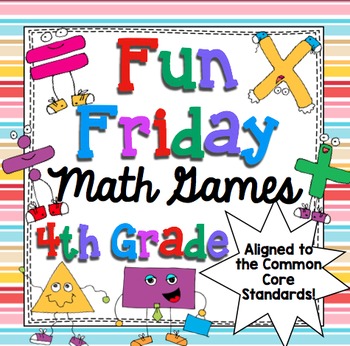4th Grade Math Games Fun Friday Math Centers Bundle
- PDF
What educators are saying
Description
Make Fridays fun and stress-free with this year long bundle of Fun Friday math games. There is a math game for every week of the school year! These games are all simple to make, explain, and play. Best of all they were developed to specifically support 4th Grade Math Standards. You can play the games on Friday and use them in math centers the next week and throughout the year!
This pack includes the following 4th grade Fun Friday math games:
QUARTER 1 Math Games:
- Big - Little Number Challenge - Students try to build the greatest and smallest numbers
- Greater Than The Gator - Players try to build a number that is greater than the gator's number
- Area Model Round Up - Players attempt to capture the most squares in an area model/array
- Multiplication Spin Out - This fast paced game allows students to challenge a partner to see who can come up with the product of a multiplication fact (sort of like the game War, except with spinners)
- Bubble Pop - Students attempt to "pop" bubbles that are multiples of a given number
- Lilly Pad Leap - Students use factors to "hop" around the lilly pads game board
- Prime or Composite Four in a Row - Students identify prime and composite numbers to earn spaces with the goal of earning 4 in a row
- Subtraction Scuba - Students attempt to get the smallest answer in a subtraction problem
- Multiplication Jungle - Players attempt to get the largest product with given numbers
- Rounding Four in a Row - Students round numbers to the nearest ten thousands and attempt to earn spaces with the goal of earning 4 in a row
QUARTER 2 Math Games:
- Division Brick Yard - Students use knowledge of division facts to climb to the top of the brickyard
- Castle Climb - Students use knowledge of equivalent fractions to "climb" to the top of the castle
- Fraction Multiplier - Students multiply fractions and whole numbers in this fast paced game
- Remainder Road Race - Students practice long division in this fun road race
- Fraction Wrangle - Students compare fractions and try to "wrangle" spaces on the game board
- Decimal Wrangle - Students compare decimals and try to "wrangle" spaces on the game board
- Symmetry Capture - Students identify lines of symmetry as they try to "capture" spaces on the game board
- Shape Property 4 In A Row - Students identify shape properties and try to get four spaces in a row
- Spin, Build, and Compare - Players build and compare decimals The Missing Length (and Width) Climb - Players solve for an unknown variable in an area problem and attempt to climb to the top of the board
QUARTER 3 Math Games:
- Fraction Decimal Memory Match - Students match fractions with denominators of 10 and 100 with equivalent decimals
- Decimal Deal - Students will compare decimals to the hundredths in a "war" style card game
- Fraction Deal - Students compare fractions in a "war" style card game
- Convert, Add, and Compare - Students convert fractions to have denominators of 100, add those fractions, and compare the sums
- Draw, Convert, and Compare - Students draw fraction cards with denominators of 10 and 100, convert them to decimals, and compare them to earn points
- Bridge Across Fractions - Students identify equivalent fractions to build a bridge across the game board
- Divide and Conquer - Students build numbers and divide them; the player with the largest quotient wins * Measurement Bubble Blast (Customary) - Students convert measurement to "blast" through bubbles
- Measurement Bubble Blast (Metric) - Students convert measurement to "blast" through bubbles
- Untangle the Angle - Players identify acute, right, and obtuse angles and measure them with a protractor
Quarter 4 Math Games:
- Remainder Round Up - Students practice 2 digit by 1 digit division with remainders
- Factor Pair Up - Four In A Row - Students find factor pairs to capture spaces and get 4 in a row
- Number Cruncher (Division, Multiplication, Addition, and Subtraction versions are included) - Players practice computation and try to outscore their opponent
- Additive Angle Safari - Players explore additive angle measurement as they move around the board
- Multiples Surf - Students move through a maze of surfboards by matching multiples
- Decimal Balloon Pop - Students match up decimals and equivalent fractions to “pop” balloons on the game board
- Divisor Quotient Spin Around - Students match divisors, quotients, and dividends to capture spaces on the game board
- Angle Capture - Students match angle types and shapes to capture spaces on the game board
- Lines 4 In A Row - Players identify lines in shapes and try to get 4 spaces in a row
The hardest part of "Fun Fridays" is coming up with a new idea each Friday. This pack has the hard work done for you! These 10 games are more than enough for an entire quarter of fun Fridays! These games are simple to prepare and they do not require special materials. They will save you hours of work!
If you would like to purchase individual quarters of these math games you can purchase them at:
Fun Friday Math Games: Quarter 1 (4th Grade)
Fun Friday Math Games: Quarter 2 (4th Grade)
Fun Friday Math Games: Quarter 3 (4th Grade)
Fun Friday Math Games: Quarter 4 (4th Grade)
If you need additional 4th grade math resources, check out the products below:
4th Grade Common Core Math Assessments - All Standards Bundle
4th Grade Math Games - Print and Play Math Games
4th Grade Common Core Test Prep - All Standards Mega Bundle
4th Grade Math Task Cards Mega Bundle All Domains and Standards





